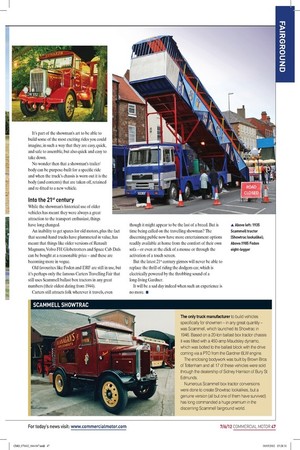Roll up, roll up...
Page 36

Page 37

Page 39

If you've noticed an error in this article please click here to report it so we can fix it.
In days of old, the showman and fairground fraternity could be relied on to turn heads with some stunning liveries and outrageous outfits. CM looks back at what’s still a travelling institution
Words/images: Bob Tuck The travelling showman has been something of a global institution as far back as anyone can remember. Giving entertainment to one and all has generally meant an itinerant lifestyle in order to attract fresh audiences every week. But unlike the road haulage world, which simply has to pick up, transport and deliver its freight, the fairground fraternity has to be selfcontained. So its working cycle is building up the fair; operating it at times to attract the paying punters then taking it down ready to move on to the next open space that is waiting down the road where the cycle is started all over again. And, of course, home was historically very much with the fair the showmen were working on.
Low mileage
Another quirk of the showman’s life is how they can be territorial, as they’ve tended to work the same parts of the country year in, year out. True, they may travel for big gatherings like the Hoppings at Newcastle, the Goose Fair at Nottingham or the huge Great Dorset Steam Fair, but generally their vehicles do a very low mileage. During the winter time when most showmen simply hibernate, their outfits are parked up for months on end.
With this sort of operation, it’s no wonder the showmen bought second-hand vehicles that could be expected to give them a long life. It helped their cause that the country’s legislators always looked kindly on them as they were generally exempted from all manner of regulations the road haulage world had to live with.
However, lawmakers have had to stretch their muscles at times. Back in the day, some of the showmen’s roadtrains could be seen hauling seven or more trailers as they travelled – sedately – to their next site. Look closely at the modern day regulations and you’ll find their limit is now three trailers – provided a heavy locomotive is used as the drawing unit. But one big concession is that as road hauliers are limited to an 18.5m overall length limit for their longest drawbar combinations, the showman’s living van roadtrain has always been legal up to 22m in length.
Let there be light
We all might take electric power for granted, but the self-sufficient showman has of course had to carry his own – or at least the means to generate it in the quantities he requires to power whatever rides he may wish to operate. And while any engine can drive – via a power take-off – a suitable dynamo, the Gardner 6LW, has been the long-term showman’s favourite. With the reputation of both frugality and long life, it’s no surprise that this old Gardner (which only ever produced 112hp) was kept in use long after the truck it may have started life with was scrapped.
It’s normal practice to carry a second engine (as a generator) on the back of the truck, as this isn’t deemed to be a vehicle’s load because it’s the showman’s trailers that are generally carrying the fee-earning rides. It’s part of the showman’s art to be able to build some of the most exciting rides you could imagine, in such a way that they are easy, quick, and safe to assemble, but also quick and easy to take down.
No wonder then that a showman’s trailer/ body can be purpose-built for a specific ride and when the truck’s chassis is worn out it is the body (and contents) that are taken off, retained and re-fitted to a new vehicle.
Into the 21st century While the showman’s historical use of older vehicles has meant they were always a great attraction to the transport enthusiast, things have long changed.
An inability to get spares for old motors, plus the fact that second-hand trucks have plummeted in value, has meant that things like older versions of Renault Magnums, Volvo FH Globetrotters and Space Cab Dafs can be bought at a reasonable price – and these are becoming more in vogue.
Old favourites like Foden and ERF are still in use, but it’s perhaps only the famous Carters Travelling Fair that still uses Scammell ballast box tractors in any great numbers (their oldest dating from 1944).
Carters still attracts folk wherever it travels, even though it might appear to be the last of a breed. But is time being called on the travelling showman? The discerning public now have more entertainment options readily available at home from the comfort of their own sofa – or even at the click of a mouse or through the activation of a touch screen.
But the latest 21st century gizmos will never be able to replace the thrill of riding the dodgem car, which is electrically powered by the throbbing sound of a long-living Gardner.
It will be a sad day indeed when such an experience is no more. n
SCAMMELL SHOWTRAC
The only truck manufacturer to build vehicles specifically for showmen – in any great quantity – was Scammell, which launched its Showtrac in 1946. Based on a 20-ton ballast box tractor chassis it was fitted with a 450-amp Maudsley dynamo, which was bolted to the ballast block with the drive coming via a PTO from the Gardner 6LW engine.
The enclosing bodywork was built by Brown Bros of Tottenham and all 17 of these vehicles were sold through the dealership of Sidney Harrison of Bury St Edmunds.
Numerous Scammell box tractor conversions were done to create Showtrac lookalikes, but a genuine version (all but one of them have survived) has long commanded a huge premium in the discerning Scammell fairground world.











































